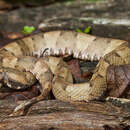en
names in breadcrumbs


The white-tailed hognose viper snake (Porthidium porrasi) is one of nine species in the exclusively New World genus Porthidium (Viperidae).It was first described as a morphologically and molecularly distinct species in 2003; previously it had been considered a variant of the abundant and wide-spread P. nasutum.Molecular analysis suggests these two species diverged about 1.7 million years ago, coinciding with volcanic action that may have caused the mountain uplift that isolates the lowland wet forests on the southwestern pacific coast of Costa Rica, where P. porrasi is found (Lamar and Sasa 2003, however see Bryson et al 2008). Neither P. nasutum nor P. volcanicum (the other Costa Rican Porthidium species) are sympatric in distribution with P. porrasi.
Distinguished by a creamy white-tipped tail, this small hognose viper has a stocky body and grows to about 40 cm (1.3 feet).A terrestrial ambush predator, its gently banded bright orange and tan patterning makes it cryptic it as it lies coiled in leaf litter; it feeds on rodents and anoline lizards (genus Anolis).Like all viperids (family Viperidae) white-tailed hognose vipers have a pair of long, hollow fangs at the front of their mouth used for injecting toxins into their prey, and they give birth to live young.The few available birth records indicate that this species has litters of six to nine young (Lamar and Sasa 2003).